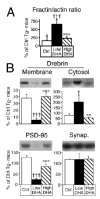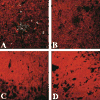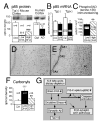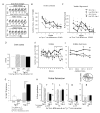Docosahexaenoic acid protects from dendritic pathology in an Alzheimer's disease mouse model
- PMID: 15339646
- PMCID: PMC2442162
- DOI: 10.1016/j.neuron.2004.08.013
Docosahexaenoic acid protects from dendritic pathology in an Alzheimer's disease mouse model
Abstract
Learning and memory depend on dendritic spine actin assembly and docosahexaenoic acid (DHA), an essential n-3 (omega-3) polyunsaturated fatty acid (PFA). High DHA consumption is associated with reduced Alzheimer's disease (AD) risk, yet mechanisms and therapeutic potential remain elusive. Here, we report that reduction of dietary n-3 PFA in an AD mouse model resulted in 80%-90% losses of the p85alpha subunit of phosphatidylinositol 3-kinase and the postsynaptic actin-regulating protein drebrin, as in AD brain. The loss of postsynaptic proteins was associated with increased oxidation, without concomitant neuron or presynaptic protein loss. n-3 PFA depletion increased caspase-cleaved actin, which was localized in dendrites ultrastructurally. Treatment of n-3 PFA-restricted mice with DHA protected against these effects and behavioral deficits and increased antiapoptotic BAD phosphorylation. Since n-3 PFAs are essential for p85-mediated CNS insulin signaling and selective protection of postsynaptic proteins, these findings have implications for neurodegenerative diseases where synaptic loss is critical, especially AD.
Figures






Comment in
-
Food for thought: essential fatty acid protects against neuronal deficits in transgenic mouse model of AD.Neuron. 2004 Sep 2;43(5):596-9. doi: 10.1016/j.neuron.2004.08.025. Neuron. 2004. PMID: 15339638 Review.
References
-
- Akbar M, Kim HY. Protective effects of docosahexaenoic acid in staurosporine-induced apoptosis: involvement of phosphatidylinositol-3 kinase pathway. J Neurochem. 2002;82:655–665. - PubMed
-
- Aksenov MY, Aksenova MV, Butterfield DA, Geddes JW, Markesbery WR. Protein oxidation in the brain in Alzheimer’s disease. Neuroscience. 2001;103:373–383. - PubMed
-
- Attwell D, Iadecola C. The neural basis of functional brain imaging signals. Trends Neurosci. 2002;25:621–625. - PubMed
-
- Bazan NG. Synaptic lipid signaling: significance of polyunsaturated fatty acids and platelet-activating factor. J Lipid Res. 2003;44:2221–33. - PubMed
Publication types
MeSH terms
Substances
Grants and funding
- AG10685/AG/NIA NIH HHS/United States
- P50 AG005142/AG/NIA NIH HHS/United States
- R01 NS043946/NS/NINDS NIH HHS/United States
- R01 AG13741/AG/NIA NIH HHS/United States
- P01 AG16570/AG/NIA NIH HHS/United States
- P50 AG05142/AG/NIA NIH HHS/United States
- AG16793/AG/NIA NIH HHS/United States
- P50 AG 16570/AG/NIA NIH HHS/United States
- R01 AG016793/AG/NIA NIH HHS/United States
- R01 AG013741/AG/NIA NIH HHS/United States
- P50 AG016570/AG/NIA NIH HHS/United States
- NS43946/NS/NINDS NIH HHS/United States
- R01 AG010685/AG/NIA NIH HHS/United States
LinkOut - more resources
Full Text Sources
Other Literature Sources
Medical
Research Materials

